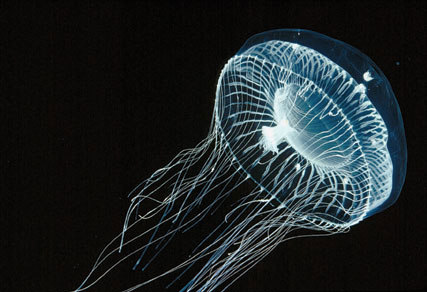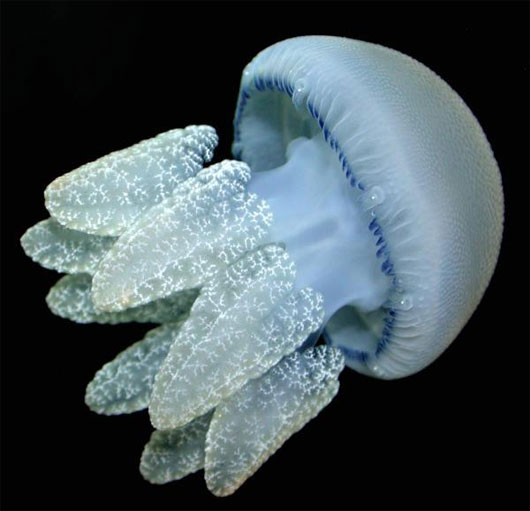65 interesting things about jellyfish (1)
The jellyfish has appeared in the ocean since more than 650 million years ago, before dinosaurs appeared on earth.

1. Jellyfish species are found throughout the world's oceans. They are even found in some freshwater lakes and in ponds.
2. The body of the jellyfish is about the size of a finger or just the tip of a pencil. But there are jellyfish with a diameter up to 2.5m, its tentacles can be up to 60m long, equivalent to the size of two blue whales.
3. Each jellyfish tentacle is composed of thousands of cells called cnidoblasts . Inside each cnidoblasts are nematocysts. Each nematocysts contains a twisted hair like a needle containing venom. When a prey is trapped in jellyfish tentacles, the pressure inside nematocysts will make these twisted needles straighten out and look like a hook. The prey will be injected into the body with these 'hooks'.
4. The main mechanism of jellyfish defense is to inject poison into the enemy and its transparent body makes it easy to hide in the ocean.
5. The jellyfish also has a part like a short tube hung in the middle of its bell-shaped body. This 'tube' plays the role of both the mouth and the digestive organ. In some jellyfish, this 'tube' is also surrounded by a piece of frill like a twisted band of ice in the water. They are also known as mouth or arm arms.
6. Jellyfish have no brain, heart, ears, head, legs or bones. Their skin is so thin that they can breathe through it.

7. While jellyfish have no brain, they have a primary nervous system with receptors that detect light, vibrations and chemicals in the water. The above possibilities along with the feeling for gravity make jellyfish easily navigable and move in the water.
8. Jellyfish are invertebrates. About 95% of its body is water.
9. Jellyfish are often found along the coast, however, scientists have discovered a jellyfish that lives at a depth of 9,000m. While most jellyfish prefer warm water, some species live in areas near the Arctic.
10 . The man-of-war (Physalia physalis) is a species that looks like a jellyfish, but in fact it is not a true jellyfish but a siphonophore . Unlike jellyfish in that it is not a single species but a population of many small individuals that live in symbiosis. They stick together and are so closely interconnected that they cannot survive independently. This species lives on the surface of the oceans. The body is actually a gas-filled bladder. Because they are unable to move themselves, they move through a combination of wind, ocean currents and tides.

Portuguese man-of-war
11 . Jellyfish tentacles can still inject poison even if it breaks from its body.
12. The smallest jellyfish in the world is creeping jellyfish. It has a diameter of only 0.5mm. This species reproduces asexually by separating their bodies. Another candidate for the title of the world's smallest jellyfish is a very toxic jellyfish named Australian Irukandji . Its size is just the nail.
13. The world's largest species of jellyfish is Nomura . Another candidate for this position is Lion's mane and Stygiomedusa gigantea.
14. Giant jellyfish is called Stygiomedusa gigantea . And it is only 17 times seen that this species has been observed for 110 years.
15. Jellyfish reproduce by mating and even asexual reproduction. Female jellyfish and jellyfish are clearly distinguished, although bisexual jellyfish are also found.
16. Jellyfish life span is only a few hours to several months. However, there is a species of jellyfish that has been reported to live up to 30 years. Jellyfish in artificial aquariums often have a higher life expectancy than when living in nature. Jellyfish are very fragile, it is easily caught by humans while still in the polyp stage. This stage is the period when they are most vulnerable.
17. Jellyfish are carnivorous but passive. They eat crustaceans, plankton, fish eggs, small fish or even other jellyfish. They eat through the mouth tube between their bodies as mentioned above.
18. Jellyfish are also the prey of some other predators such as sharks, tuna, swordfish, sea turtles and some Pacific salmon species.
19. There is a jellyfish named Turritopsis nutricula , it is also called the 'immortal jellyfish'. Because it is so named because it can be transferred from a mature jellyfish to a polyp form, the nature of this is to avoid death for them. Jellyfish that do this through a cell development process are called transdifferentiation.

Turritopsis nutricula - Immortal jellyfish
20. There is a special jellyfish found on the coast of North America and Europe called moon jellyfish (Moon jellyfish). This species is green or pink and lives at a depth of about 6m. Its toxin is mild but can cause itching or red rash on the skin.
21. Even a dead jellyfish still has the ability to inject poison.
22. Jellyfish have appeared in the ocean since more than 650 million years ago, before dinosaurs appeared on earth.
23. Portuguese man-of-war can be up to 50m long, although normally 30m. Portuguese man-of-war can sometimes appear in groups of up to 1,000 individuals, they appear in warm waters. To avoid danger, their air bladder may collapse to sink below the water surface.
 Jellyfish moon
Jellyfish moon
24. When a jellyfish is upside down, it does not float in the water. Instead, it anchors itself to the ocean floor. It looked like seaweed plants then.
25. Science has recorded 2,000 different species of jellyfish. Among them, 70 species can cause damage to humans. The box jellyfish (Chironex fleckeri) is the most dangerous species. Scientists believe that there may be as many as 300,000 other jellyfish that have not been discovered.
26. Jellyfish (Jellyfish) is not a fish. It is actually a Cnidari a phytoplankton (in Greek, ' Nettles') and Scyphoza (in Greek, 'The cup'). Some aquariums are trying to popularize the terms 'jellies' or 'sea jellies' instead of 'jellyfish' to avoid misunderstandings about this species.
27. Atolla jellyfish is a fairly common marine animal, found in every ocean in the world, at a depth of 700m below sea level. Atolla jellyfish does not use the glowing ability to catch prey but to flee. When captured by the enemy, Atolla jellyfish emits beautiful flashes of light to attract larger fish to eat the enemy. This jellyfish uses tentacles to catch prey.

Atolla jellyfish
28. The explosion of jellyfish can reach more than 500 million individuals, with the size of each animal equivalent to the size of a refrigerator.
29. The crabs are sometimes seen 'hitchhiking' on the bodies of the jellyfish. Hard shells of crabs help protect them from jellyfish poison. Crabs also often get food in the jellyfish tentacle trap.
30 The jellyfish body has more than 95% water. So if they leave the water environment, they will shrink and die.
31. Jellyfish move in two basic ways. They use water in their bell-shaped bodies to push back, creating a jet to move forward. In addition, they move by drifting along the ocean currents.
32. The body of the jellyfish consists of six parts. The inner part is gastrodermis . The compartments are called gastrovascular . The middle layer is a thick layer of substance called mesoglea . Outside is a cuticle. It also has a tassel and tentacles.
(continue)
- 65 interesting things about jellyfish (2)
- 10 interesting things about life you may not know
- The evolutionary secret helps jellyfish survive without the heart and brain
- Jellyfish species can 'knock down' American carriers
- Beautiful sparkling jellyfish kingdom
- Do you know how jellyfish burn us?
- How to handle when being stung by jellyfish and cramps during summer bathing
- Beauty of jellyfish in the dark
- Discover strange strange jellyfish of seven colors
- Startled with the danger of jellyfish invading the oceans
- Jellyfish cannot 'invade' the planet
- 10 interesting things about nature you may not know
 Surprised: Fish that live in the dark ocean still see colors
Surprised: Fish that live in the dark ocean still see colors Japan suddenly caught the creature that caused the earthquake in the legend
Japan suddenly caught the creature that caused the earthquake in the legend A series of gray whale carcasses washed ashore on California's coast
A series of gray whale carcasses washed ashore on California's coast Compare the size of shark species in the world
Compare the size of shark species in the world